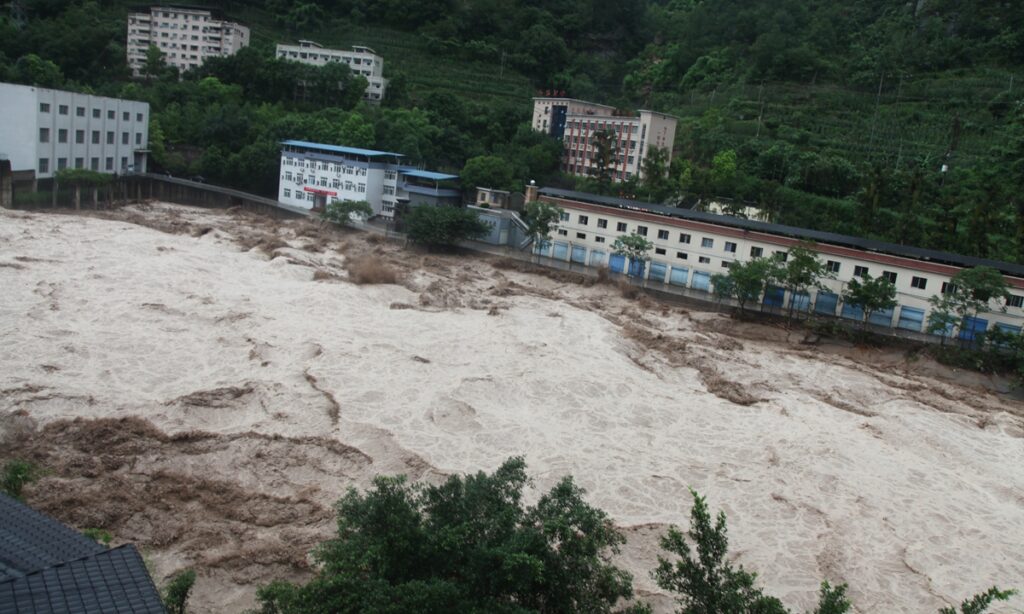Heavy rains and floods lashed multiple places in China over the weekend and wild temperature swings are expected to continue in the following days, as the country enters its peak rainy season, which is expected to last till early August.
Flash floods caused by the rainstorm have led to landslides and mudslides in Hangzhou, East China’s Zhejiang Province over the weekend, and five people had died and three had gone missing in multiple places due to multiple causes.
China’s National Meteorological Center (NMC) issued on Sunday morning a blue warning for rainstorms in multiple places, including parts of North China’s Inner Mongolia Autonomous Region and Northeast China’s Heilongjiang and Jilin provinces, between Sunday afternoon and Monday afternoon.
The NMC warned that rainstorms of 100-140 millimeters are expected to hit the southwestern part of the Sichuan Basin during this period of time. Other places such as parts of Northwest China’s Gansu Province and East China’s Jiangxi and Fujian provinces can also expect maximum hourly rainfall of 30 millimeters to 50 millimeters, with some places exceeding 60 millimeters.
This year has seen more rainstorms than usual which could be the result of climate change, Lin Boqiang, director of the China Center for Energy Economics Research at Xiamen University, told the Global Times on Sunday.
According to Lin, the extreme climate and global warming caused by El Nino and carbon emissions have resulted in instability of the entire ecosystem, which has become more intense and unpredictable in recent years.
According to the NMC, heavy rainfall was mainly distributed in the northern and southern parts of the country on Saturday. Rainstorms hit provinces including Liaoning, Jilin, Heilongjiang and Inner Mongolia. Down south, heavy rainfall was mainly distributed in the middle and eastern parts of the region immediately south of the Yangtze River.
In particular, cities such as Huludao and Jinzhou in Liaoning and Hangzhou in East China’s Zhejiang Province suffered from rainstorms bringing rainfall between 180 millimeters and 209 millimeters. The maximum hourly rainfall ranged from 80 millimeters to 100 millimeters.
Multiple places in Liaoning were gripped by the first widespread downpours of the year starting on Friday and more than 2,400 personnel had been relocated as of Saturday afternoon. Additionally, 11 cities and 78 counties have launched emergency responses, with no disasters reported.
In Hangzhou, rainstorms have swept through the city since Saturday noon with some areas including Fuyang, Jiande and Xiaoshan suffering from heavy downpours. A village in Dayuan town in Fuyang saw a maximum accumulated rainfall of 202.5 millimeters between noon and 7 pm on Saturday.
Flash floods caused by the rainstorm led to landslides and mudslides in Fuyang during the period between Saturday night and the early hours of Sunday. As of 2 pm on Sunday, five people had died and three had gone missing in multiple places due to multiple causes.
It was estimated that the rainstorm had caused 32 flash floods, 144 geological disasters, the damage or collapse of 26 houses and leaving 1,619 households with no power, 42 vehicles submerged and 21 roads cut off by floodwater.
A viral video clip shows muddy water gushing through the streets in a village in Dayuan township, pouring into houses and carrying away vehicles. Officials from the township government told the media that relocation of the residents impacted by the disaster is still ongoing as more rainstorms are expected in the following days.
The NMC forecast on Sunday a medium risk of rainstorms in places including Jilin, Heilongjiang, Southwest China’s Chongqing Municipality, Sichuan Province and the Xizang (Tibet) Autonomous Region, warning of the possible occurrence of floods in small and medium-sized rivers, mountain floods, geological disasters, urban and rural waterlogging and other hazards caused by the wild weather swings.
China’s Ministry of Natural Resources and the NMC issued on Sunday evening a joint meteorological risk warning for geological disasters between 8 pm on Sunday and 8 pm on Monday, while parts of western Jiangxi, the middle and eastern parts of Central China’s Hunan Province and the middle part of Sichuan were issued a yellow warning for geological disasters.
(Global Times)



